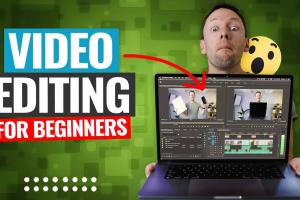Mastering Video Editing: A Comprehensive Guide for Beginners

-
Quick Links:
- 1. Introduction
- 2. Understanding Video Editing
- 3. Choosing Video Editing Software
- 4. Basic Video Editing Techniques
- 5. Advanced Editing Techniques
- 6. Adding Effects and Transitions
- 7. Audio Editing
- 8. Exporting Your Video
- 9. Case Studies
- 10. Expert Insights
- 11. FAQs
1. Introduction
Video editing has become an essential skill in today's digital age. With the rise of platforms like YouTube, TikTok, and Instagram, more people are looking to create engaging video content. This comprehensive guide is designed for beginners who want to learn how to edit videos effectively. Whether you're creating content for social media or personal projects, mastering video editing can elevate your work to the next level.
2. Understanding Video Editing
Video editing is the process of manipulating and rearranging video footage to create a new work. It involves several stages, including:
- Video Capture
- Importing Footage
- Cutting and Trimming
- Adding Effects and Transitions
- Audio Editing
- Exporting the Final Product
Understanding these stages is crucial for effective video editing.
3. Choosing Video Editing Software
The first step in your video editing journey is selecting the right software. There are numerous options available, ranging from free to paid software. Here are some popular choices:
- iMovie: Great for beginners using Mac.
- Windows Movie Maker: User-friendly for Windows users.
- Adobe Premiere Pro: Industry-standard with advanced features.
- DaVinci Resolve: Powerful free option with professional-grade tools.
Consider your budget, the complexity of your projects, and your operating system when making your choice.
4. Basic Video Editing Techniques
As a beginner, mastering basic techniques is essential. Here are some key techniques to focus on:
4.1 Cutting and Trimming
Learn how to cut out unnecessary footage and trim clips for better pacing.
4.2 Adding Text
Incorporate titles, captions, and credits to enhance your storytelling.
4.3 Color Correction
Adjust brightness, contrast, and saturation to improve visual appeal.
5. Advanced Editing Techniques
Once you've mastered the basics, explore advanced techniques such as:
5.1 Keyframing
Learn how to create animations and dynamic effects by setting keyframes.
5.2 Multi-Camera Editing
Edit footage from multiple cameras for a professional look.
5.3 Green Screen Editing
Use chroma keying to replace backgrounds and create immersive scenes.
6. Adding Effects and Transitions
Transitions help your video flow smoothly from one scene to another. Here are some popular transitions:
- Fade In/Out
- Cross Dissolve
- Wipe Transitions
Adding effects such as slow motion or speed ramping can also enhance your video’s storytelling.
7. Audio Editing
Good audio is just as important as good video. Here’s how to edit audio effectively:
- Adjust Volume Levels
- Remove Background Noise
- Add Music and Sound Effects
8. Exporting Your Video
Once you've completed editing, it's time to export your video. Ensure you choose the right format for your platform:
- MP4: Best for most platforms.
- AVI: Good for high-quality videos.
- WMV: Suitable for Windows users.
9. Case Studies
To illustrate the impact of good video editing, let’s look at a few successful YouTube channels that started from scratch:
- Unbox Therapy: Started with basic editing and now employs advanced techniques.
- NikkieTutorials: Used color correction and effects to enhance her beauty tutorials.
10. Expert Insights
We consulted with professional video editors to get their tips:
"Focus on storytelling. Great editing is about guiding your audience through a narrative." - Jane Doe, Pro Editor.
11. FAQs
1. What video editing software is best for beginners?
Software like iMovie and DaVinci Resolve are excellent starting points.
2. How long does it take to learn video editing?
It varies by individual, but with consistent practice, you can grasp the basics in a few weeks.
3. Do I need a powerful computer for video editing?
A decent computer with a good processor and sufficient RAM is recommended for smooth editing.
4. Can I edit videos on my phone?
Yes, apps like Kinemaster and InShot allow mobile video editing.
5. What is the best video format for YouTube?
MP4 is the most recommended format for YouTube uploads.
6. How can I improve my video editing skills?
Practice regularly, watch tutorials, and analyze videos you admire.
7. Is video editing hard?
It can be challenging at first, but with practice and patience, it becomes easier.
8. What are some common mistakes in video editing?
Common mistakes include overusing effects, neglecting audio quality, and poor pacing.
9. How important is audio in video editing?
Audio is crucial; poor sound quality can ruin an otherwise great video.
10. Should I take a video editing course?
Taking a course can provide structured learning and expert guidance.
Random Reads
- Mastering mailbox lock picking
- Mastering matlab functions
- How to climb a ladder safely
- How to clone hard drive to ssd
- Microsoft excel open password protected spreadsheet
- How to connect ps3 to computer speakers
- How to change default web browser mac
- How to change chrome icon
- How to get whatsapp on apple watch
- How to enter exit dfu mode iphone 8